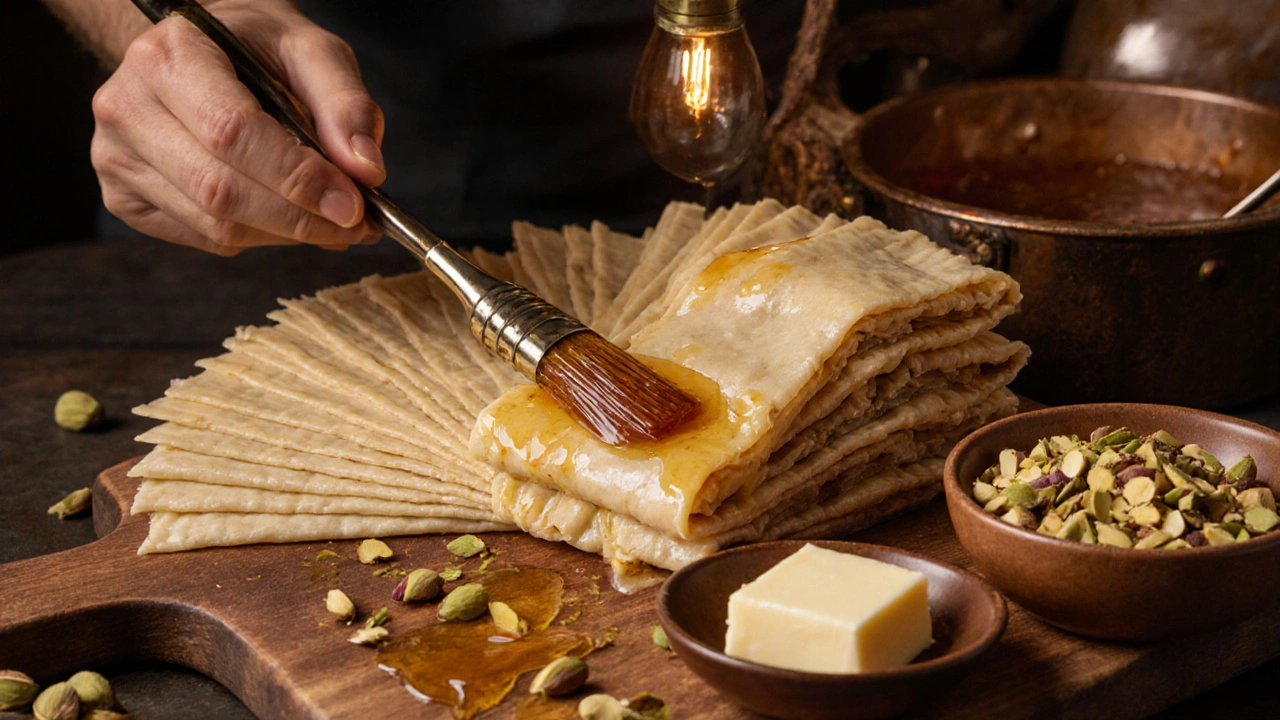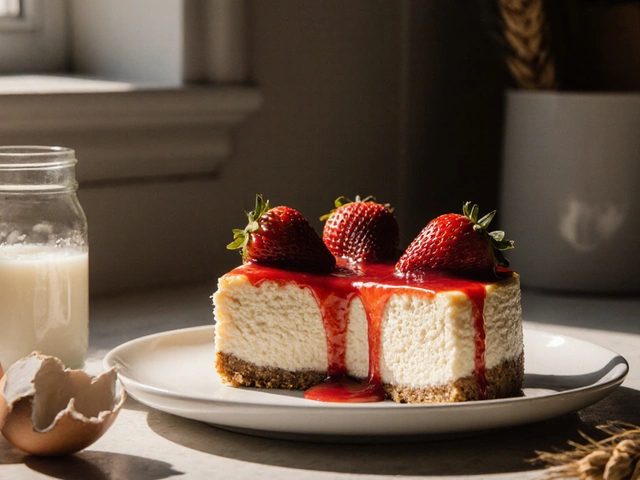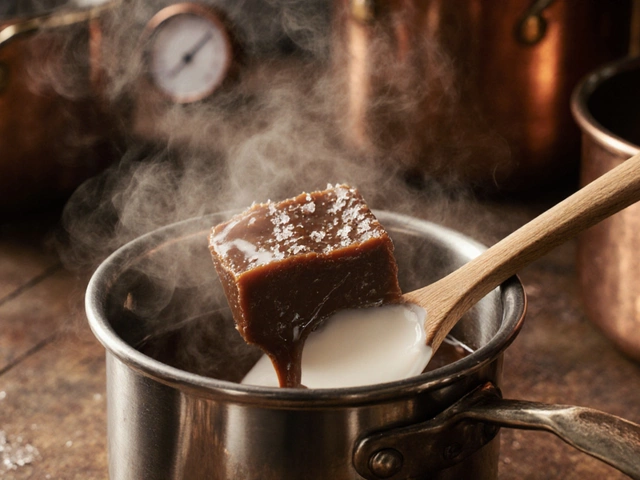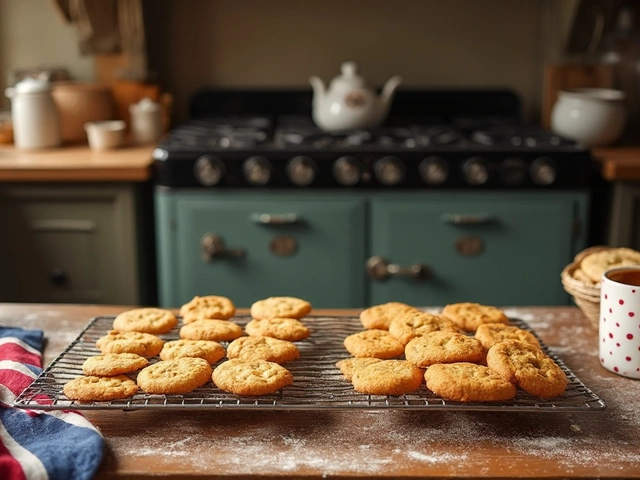Vegan Baklava Ingredient Checker
Results
Non-Vegan Ingredients to Avoid
Butter
Dairy product made from cow's milk. Used for flakiness in phyllo layers.
Swap: Vegan margarine or coconut oilHoney
Sweet syrup produced by bees. Considered animal-exploitation by vegans.
Swap: Maple syrup, agave nectar, or date syrupGelatin
Animal collagen derived from hides. Used for thickening syrup.
Swap: Agar-agar or pectinDairy-based Syrups
Milk, cream, or yogurt used for creaminess in syrup.
Swap: Plant milk + sugarEver wondered why the beloved Middle‑Eastern pastry baklava often shows up on the ‘not vegan’ list? The answer lies in a handful of classic ingredients that clash with a plant‑based lifestyle. In this guide we’ll break down each non‑vegan component, explain why it matters, and show you practical swaps so you can still enjoy those flaky layers without compromising your ethics.
Quick Takeaways
- Traditional baklava relies on butter and honey - both animal‑derived.
- Some recipes also use gelatin or dairy‑based syrups.
- Vegan versions replace butter with oil or plant‑based margarine and sweeten with maple syrup or agave.
- Read labels carefully; “phyllo” is usually brushed with butter.
- Store‑bought vegan baklava is available, but homemade gives you full control.
What Exactly Is Baklava?
Baklava is a layered pastry made from thin sheets of phyllo dough, chopped nuts, and a sweet syrup. Originating in the Ottoman Empire, it has become a staple across Greece, Turkey, the Middle East, and even the Balkans.
The magic comes from stacking dozens of buttery phyllo sheets, sprinkling pistachios or walnuts in between, then drenching the baked cake in a hot syrup. The result is a crisp‑yet‑chewy delight that’s hard to resist.
Classic Non‑Vegan Ingredients
Let’s go ingredient by ingredient and see why each one can disqualify baklava from a vegan diet.
Butter
Butter is a dairy product made by churning cream from cow’s milk. It’s prized for its rich flavor and ability to create that signature flakiness in phyllo layers.
Since butter’s origin is animal‑based, vegans avoid it. It also adds saturated fat, which some plant‑based eaters try to limit.
Honey
Honey is a sweet syrup produced by honeybees from nectar. It’s often used in the finishing syrup because of its distinctive floral notes.
Vegans consider honey off‑limits because it involves animal exploitation. Even if the bees aren’t harmed, the practice still exploits insects for human benefit.
Gelatin (Rare but Present)
Some modern baklava recipes employ gelatin to stabilize the syrup or give the pastry a glossy finish. Gelatin is derived from animal collagen, typically from pork or beef hides.
If you find gelatin listed, the dessert is definitely non‑vegan.
Dairy‑Based Syrup Add‑Ons
A few variations use milk, cream, or even yogurt in the syrup for extra creaminess. These dairy derivatives, like butter, are animal‑based.
Phyllo Dough - The Hidden Guest
While the base dough itself is usually just flour, water, and a pinch of salt, commercial phyllo sheets are often sold pre‑brushed with butter. That thin layer of animal fat sneaks the non‑vegan element into every bite.
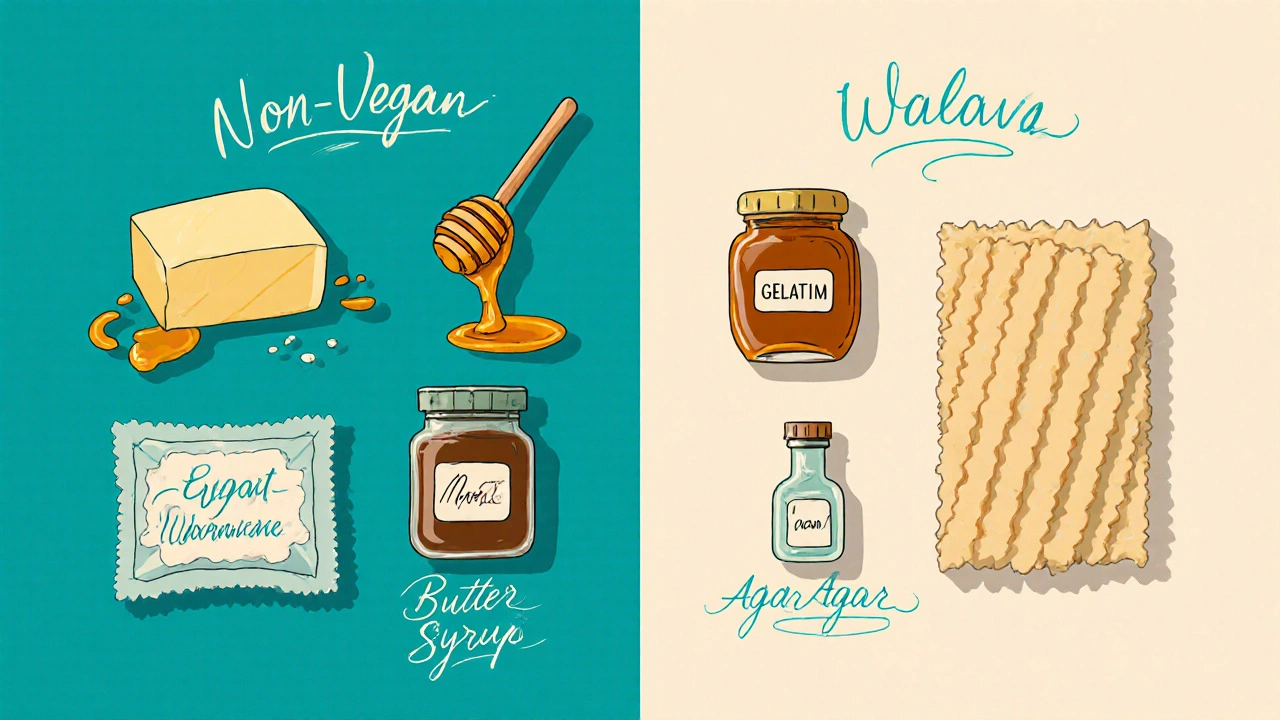
Why These Ingredients Matter to Vegans
Vegans avoid animal products not just for dietary reasons but also for ethical, environmental, and health motivations. Butter and honey contribute to animal exploitation, while gelatin represents a use of animal by‑products that vegans reject outright. Even tiny traces can break a vegan certification, so knowing each component is crucial.
Vegan Swaps: Re‑Creating Baklava Without Animal Products
Good news: you can mimic the classic flavor and texture using plant‑based alternatives. Below is a quick rundown of the most reliable swaps.
- Butter → Vegan Margarine or Coconut Oil: Choose a neutral‑tasting vegan margarine or melt refined coconut oil and brush it on phyllo. Both create crisp layers without a dairy taste.
- Honey → Maple Syrup, Agave Nectar, or Date Syrup: These liquid sweeteners have comparable viscosity and dissolve well in hot syrup, delivering a mellow sweet note.
- Gelatin → Agar‑Agar or Pectin: Dissolve a pinch of agar‑agar in the hot syrup if you need extra body; it sets quickly and is 100% plant‑based.
- Dairy Syrup → Plant Milk (almond, oat) + Sugar: Simmer plant milk with sugar and a splash of lemon juice for a creamy‑ish finish.
- Phyllo Dough → Vegan‑Certified Phyllo or Homemade: Look for brands that explicitly state “no butter” or make your own thin sheets using only flour, water, and oil.
Step‑by‑Step Vegan Baklava Recipe
- Preheat oven to 350°F (175°C). Grease a 9×13‑inch baking dish with a thin layer of melted coconut oil.
- Lay the first sheet of vegan‑certified phyllo; brush generously with melted coconut oil. Repeat until you have 8 layers.
- Spread a mixture of chopped pistachios, walnuts, and a pinch of cinnamon over the top.
- Cover with another 8 sheets of phyllo, brushing each sheet with oil.
- Trim excess dough, score the pastry into diamonds, and bake for 45‑50 minutes until golden.
- Meanwhile, make the syrup: combine 1 cup maple syrup, ½ cup water, 1 Tbsp lemon juice, and a small cinnamon stick. Bring to a boil, then simmer 5 minutes.
- When the baklava is out of the oven, pour the hot syrup over it evenly. Let it sit for at least 2 hours before serving.
Result? A dairy‑free, honey‑free baklava that still delivers the same crunchy‑sweet experience.
Buying Vegan Baklava: What to Look For
If you prefer store‑bought options, scan the ingredient list for key red flags: butter, honey, gelatin, milk, cream, or “phyllo pastry (contains butter).” Many specialty vegan bakeries label their pastries clearly, but mainstream supermarkets may only list "phyllo" without specifying the brushing oil.
Look for certifications such as the Vegan Society logo, or check the brand’s website for a full ingredient breakdown.
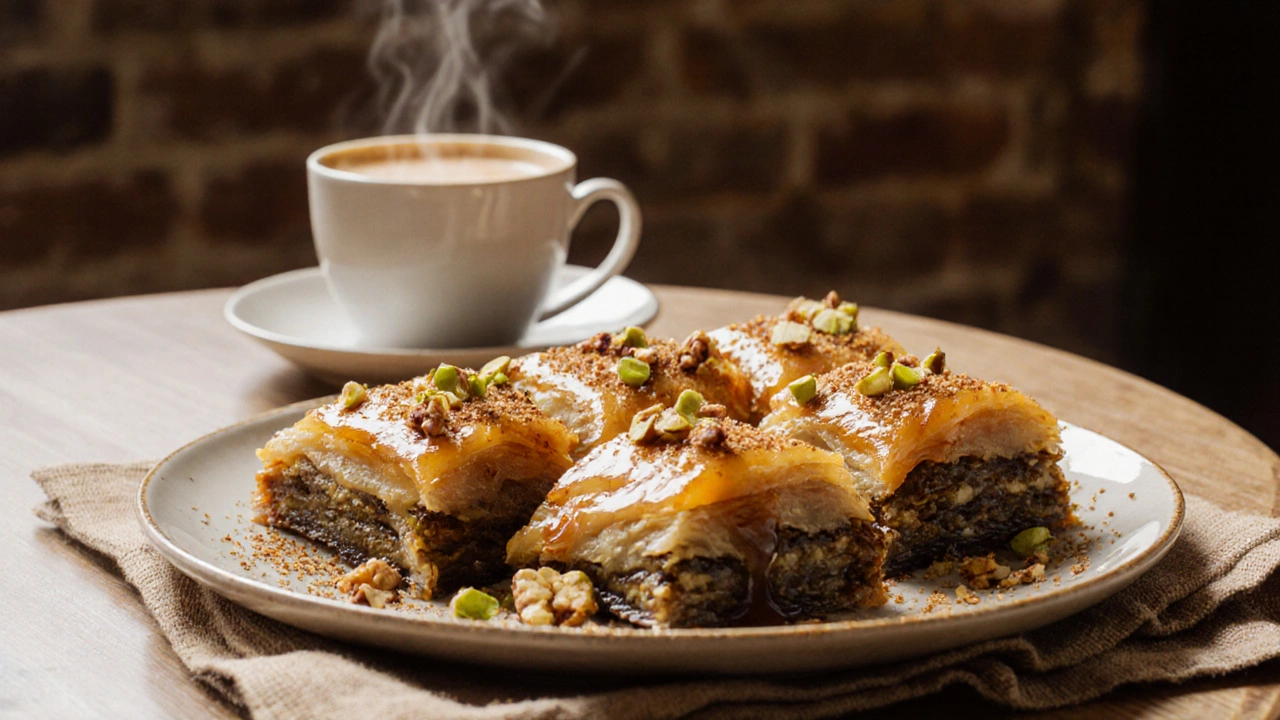
Common Misconceptions
- “All baklava is vegan if it’s nut‑based.” - Wrong. The fat in the layers (butter) is the real culprit.
- “Maple syrup tastes too different from honey.” - Not really. In the hot syrup, the flavors blend with nuts and spices, making the difference subtle.
- “If a recipe says ‘vegan‑friendly,’ it’s safe.” - Always verify; some “vegan‑friendly” versions still contain honey or dairy‑based butter substitutes.
Comparison: Traditional vs. Vegan Baklava
| Aspect | Traditional | Vegan |
|---|---|---|
| Fat Source | Butter (dairy) | Vegan margarine or coconut oil |
| Sweetener in Syrup | Honey (animal‑derived) | Maple syrup / agave nectar |
| Thickener (optional) | Gelatin (animal collagen) | Agar‑agar or none |
| Phyllo Preparation | Pre‑brushed with butter | Brush with plant oil |
| Flavor Profile | Rich, buttery, floral | Similar - slight coconut/oil note |
| Vegan Certification | No | Yes (if all swaps used) |
Tips for Perfect Vegan Baklava
- Keep phyllo sheets covered with a damp towel; they dry out fast.
- Use a pastry brush for an even oil layer; too much makes it greasy, too little reduces flakiness.
- Allow the syrup to cool slightly before pouring; a scorching hot pour can soggify the layers.
- Store leftovers in an airtight container at room temperature for up to three days. Refrigeration makes the pastry lose its crunch.
- Experiment with spices - a pinch of cardamom or orange zest can give your vegan baklava a unique twist.
Frequently Asked Questions
Is honey the only animal ingredient in baklava?
No. Traditional baklava also uses butter (or ghee) in the phyllo layers, and some modern recipes add gelatin or dairy‑based syrups. All of these are animal‑derived.
Can I use regular butter and still call it vegan if I swap the honey?
No. Vegan standards require that *all* animal products be absent. Butter is a dairy product, so using it makes the pastry non‑vegan regardless of the sweetener.
Do vegan baklava versions taste the same?
They’re remarkably close. The key is using a good quality vegan margarine or refined coconut oil, which mimics butter’s crispness, and a maple or agave syrup that provides similar sweetness. The nut and spice combo does most of the heavy lifting.
Is there a gluten‑free vegan baklava?
Yes. Replace phyllo with a gluten‑free filo substitute (many are made from rice or almond flour) and follow the same vegan fat and sweetener guidelines. The texture may be slightly different but still delicious.
Where can I buy vegan baklava?
Specialty vegan bakeries, health‑food stores, and some ethnic markets label their pastries as vegan. Online vegan dessert shops also ship fresh baklava. Always check the ingredient list for butter, honey, or gelatin.

